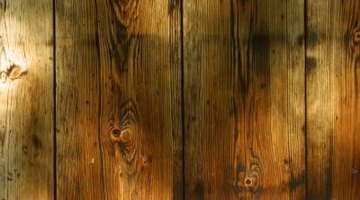Textures of the Walls in Homes in the 40s and 50s
Every time period has its own signature home decor and styles. The 1940s and 50s marked a housing boom, with post World War II construction adding colorful ranches and colonial revivals to the suburban landscape. Homes built during the mid-century period were packed with textures that ran the gamut from smooth gypsum walls to raised wallpapers.
Gypsum Walls

Flat, smooth gypsum walls were a primary feature of the mid-20th-century home. According to the Gypsum Association, half of the homes built during the 50s had walls made from lightweight gypsum lath and plaster, while the other half had a gypsum wallboard construction. Gypsum products produced smooth-textured walls. With a coat or two of fresh paint, the gypsum walls of the 1940s and 1950s were smoothly textured to the touch and the eyes.
Paneling
A noticeable retro look of the 1950s is the decade's signature wood paneling. This naturally textured wall material came in many shades and varieties from deep cherries to lighter walnuts. Instead of the more traditional smooth-painted wall, the paneled wall provides a completely different look and feel to the room. Popularized in dens, family and rec rooms, real wood paneling during the mid-century time period brought a warmth to almost any room. The knotty finish that most 50s paneling features adds an extra level of texture to this distinct wall covering.
Wallpapers
Another way that home builders and decorators of the 40s and 50s used texture in interior room design was through specially made wallpapers. Covering smoothly textured walls with a fabric or textured paper or heavily patterned print was a well-known way to enhance the overall room decor during the mid-century time period. Although wallpaper doesn't represent the actual texture of the wall, it was an easy way for the homeowner to transform a smooth gypsum board or bumpy plaster job into a more modern look.
Plaster
Although smoother gypsum walls were a design staple beginning in the 1940s, the use of unevenly textured plaster was not entirely uncommon. Walls of the mid-century home often feature layers of plaster, providing a bumpy or at times rough feel. Modern-day homes that were built in the 50s or earlier often have layers of chunky wallpaper meant to cover these imperfectly textured walls. Unlike contemporary textured paints that supply a uniform pattern or look, a roughly textured plaster wall has a distinctively country or rustic appearance.
References
Writer Bio
Based in Pittsburgh, Erica Loop has been writing education, child development and parenting articles since 2009. Her articles have appeared in "Pittsburgh Parent Magazine" and the website PBS Parents. She has a Master of Science in applied developmental psychology from the University of Pittsburgh's School of Education.
Photo Credits
- Photos.com/Photos.com/Getty Images
More Articles



